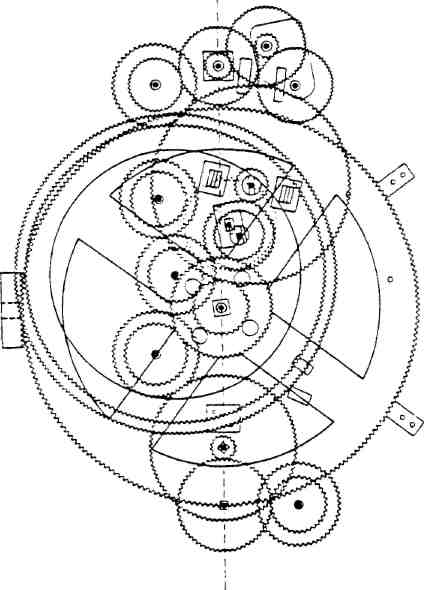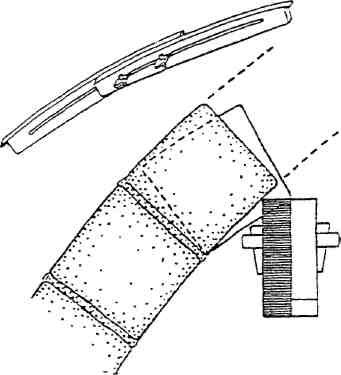Darwin's Dangerous Idea (43 page)
Read Darwin's Dangerous Idea Online
Authors: Daniel C. Dennett

1. THE POWER OF ADAPTATIONIST THINKING
CHAPTER 9:
The task of reverse engineering in biology is an exercise in
figuring out "what Mother Nature had in mind." This strategy, known as
'Naked as Nature intended' was a persuasive slogan of the early Naturist
adaptationism, has been an amazingly powerful method, generating many
movement. But Nature's original intention was that the skin of all
spectacular leaps of inference that have been confirmed
—
along with some
primates should be un-naked.
that have not, of course. The famous critique of adaptationism by Stephen Jay
—ELAINE MORGAN 1990, p. 66
Gould and Richard Lewontin focuses attention on the suspicions people have
harbored about adaptationism, but is largely misdirected. The applications of
Judging a poem is like judging a pudding or a machine. One demands
game theory in adaptationism have been particularly fruitful, but one must be
that it work. It is only because an artifact works that we infer the
cautious: there may be more hidden constraints than theorists often assume.
intention of an artificer.
—W. WIMSATT and M. BEARDSLEY 1954, p. 4
If you know something about the design of an artifact, you can predict its behavior without worrying yourself about the underlying physics of its parts.
Even small children can readily learn to manipulate such complicated objects as VCRs without having a clue as to how they work; they know just what will happen when they press a sequence of buttons, because they know what is designed to happen. They are operating from what I call the
design stance.
The VCR repairer knows a great deal more about the design of the VCR, and knows, roughly, how all the interior parts interact to produce both proper functioning and pathological functioning, but may also be quite oblivious of the underlying physics of the processes. Only the designers of the VCR had to understand the physics; they are the ones who must descend to what I call the
physical stance
in order to figure out what sorts of design revisions might enhance picture quality, or diminish wear and tear on the tape, or reduce the electricity consumption of the product. But when they engage in
reverse
engineering—of some other manufacturer's VCR, for instance—they avail themselves not only of the physical stance, but also of what I call the
intentional stance
—they try to figure out
what the designers



230 SEARCHING FOR QUALITY
The Power of Adaptationist Thinking
231
dating from ancient Greece, is an astonishingly complex assembly of bronze gears. What was it for? Was it a clock? Was it the machinery for moving an automaton statue, like Vaucanson's marvels of the eighteenth century? It was—almost certainly—an orrery or a planetarium, and the proof is that it would be a
good
orrery. That is, calculations of the periods of rotation of its wheels led to an interpretation that would have made it an accurate ( Ptole-maic ) representation of what was then known about the motions of the planets.
The great architectural historian Viollet-le-Duc described an object called a
cerce,
used somehow in the construction of cathedral vaults.
He hypothesized that it was a movable piece of staging, used as a temporary support for incomplete web-courses, but a later interpreter, John Fitchen ( 1961), argued that this could not have been its function. For one thing, the cerce would not have been strong enough in its extended position, and, as figure 9.2 shows, its use would have created irregularities in the vault webbing which are not to be found. Fitchen's extended and elaborate FIGURE 9.1. Figure diagramming the wheel-work of the Antikythera mechanism by Derek de-Solla Price (Yale University)
had in mind.
They treat the artifact under examination as a product of a process of
reasoned
design development, a series of
choices
among alternatives, in which the
decisions
reached were those
deemed best
by the designers. Thinking about the postulated functions of the parts is making assumptions about the
reasons
for their presence, and this often permits one to make giant leaps of inference that finesse one's ignorance of the Viollet-le-Duc's cerce device as support for each web course during the erection of underlying physics, or the lower-level design elements of the object.
the vault. The smaller-scale drawing shows a cerce, based on Viollet-le-Duc's rep-Archeologists and historians sometimes encounter artifacts whose mean-resentation and description. Its extended position clearly indicates how one slotted ing—whose function or purpose—is particularly obscure. It is instructive to board laps the other. Hung vertically as support for the stones of a web course, it is look briefly at a few examples of such
artifact hermeneutics
to see how one seen (in the detailed section) that the stones of any given course cannot line up reasons in such cases.1
throughout: those that lean against the far board (shown in outline) tilt much more The Antikythera mechanism, discovered in 1900 in a shipwreck, and than those that lean against the near board (shown hatched). As no such break does occur in the alignment of the web stone-coursing, it is obvious that the cerce device was not used in this fashion, in spite of Viollet-le-Duc's assertion that it was. [Fitchen 1. For an expanded analysis of these issues, see Dennett 1990b.
1961, p. 101.]
FIGURE 9.2
232 SEARCHING FOR QUALITY
The Power of Adaptationist Thinking
233
argument concludes that the cerce was no more than an adjustable template, a but there is no denying the fruits of the strategy. In chapters 7 and 8, we saw conclusion he supports by coming up with a much more elegant and versatile how the engineering perspective informs research at every level from the solution to the problem of temporary support of web courses.
molecules on up, and how this perspective
always
involves distinguishing the The important feature in these arguments is the reliance on optimality better from the worse, and the reasons Mother Nature has found for the considerations; it counts against the hypothesis that something is a cherry -
distinction. The intentional stance is thus the crucial lever in all attempts to pitter, for instance, if it would have been a demonstrably inferior cherry-reconstruct the biological past. Did
Archaeopteryx,
the extinct birdlike pitter. Occasionally, an artifact loses its original function and takes on a new creature that some have called a winged dinosaur, ever really get off the one. People buy old-fashioned sadirons not to iron their clothes with, but to ground? Nothing could be more ephemeral, less likely to leave a fossil trace, use as bookends or doorstops; a handsome jam pot can become a pencil-than a flight through the air, but if you do an engineering analysis of its holder, and lobster traps get recycled as outdoor planters. The fact is that claws, they turn out to be excellent adaptations for
perching on branches,
not sadirons are much better as bookends than they are at ironing clothes— when for
running.
An analysis of the claw curvature, supplemented by aerodynamic compared with the competition today. And a Dec-10 mainframe computer analysis of the archaeopteryx wing structure, makes it quite plain that the today makes a nifty heavy-duty anchor for a large boat-mooring. No artifact creature was
well designed
for flight (Feduccia 1993 ). So it almost certainly is immune from such appropriation, and however clearly its
original
purpose flew—or had ancestors that flew (we mustn't forget the possibility of excess may be read from its current form, its new purpose may be related to that functionality persisting, like the computer in the word-processor). The original purpose by mere historic accident—the fellow who owned the hypothesis that the archaeopteryx flew has not yet been fully confirmed to obsolete mainframe needed an anchor badly, and opportunistically pressed it every expert's satisfaction, but it suggests many further questions to address into service.
to the fossil record, and when those questions are pursued, either the evidence The clues about such historical processes would be simply unreadable will mount in favor of the hypothesis or it won't. The hypothesis is testable.
without assumptions about optimality of design. Consider the so-called ded-The lever of reverse engineering is not just for prying out secrets of icated word-processor—the cheap, portable, glorified typewriter that uses history; it is even more spectacular as a predictor of unimagined secrets of disk storage and an electronic display screen, but can't be used as an all-the present. Why are there colors? Color-coding is generally viewed as a purpose computer. If you open up one of these devices, you find it is recent engineering innovation, but it is not. Mother Nature discovered it governed by an all-purpose CPU or central processing unit, such as an 8088
much earlier (for the details, see the section on why there are colors in chip—a full-power computer vastly more powerful, swift, and versatile than Dennett 1991a, pp. 375-83). We know this thanks to lines of research opened the biggest computer Alan Turing ever saw—locked into menial service, up by Karl von Frisch, and, as Richard Dawkins points out, von Frisch used a performing a minuscule fraction of the tasks it
could
be harnessed to perform.
bold exercise in reverse engineering to make the initial move.
Why is all this excess functionality found here? Martian reverse engineers might be baffled, but there is a simple historical explanation, of course: the Von Frisch (1967), in defiance of the prestigious orthodoxy of von Hess, genealogy of computer development gradually lowered costs of chip conclusively demonstrated colour vision in fish and in honeybees by con-manufacture to the point where it was much cheaper to install a whole trolled experiments. He was driven to undertake those experiments by his computer-on-a-chip in a device than to build a special-purpose control refusal to believe that, for example, the colours of flowers were there for circuit. Notice that the explanation is historical but also, inescapably, prono reason, or simply to delight men's eyes. [Dawkins 1982, p. 31.]
ceeds from the intentional stance. It became
wise
to design dedicated word-processors this way, when the cost-benefit analysis showed that this was the A similar inference led to the discovery of the endorphins, the morphine-best, cheapest way to
solve the problem.
like substances that we produce in our own bodies when we are put under What is amazing is how powerful the intentional stance can be in reverse enough stress or pain—creating the "runner's high," for instance. The rea-engineering, not only of human artifacts, but also of organisms. In chapter 6, soning was the reverse of von Frisch's. Scientists found receptors in the brain we saw the role of practical reasoning—cost-benefit analysis in particular—
that are highly specific for morphine, which has a powerful painkilling effect.